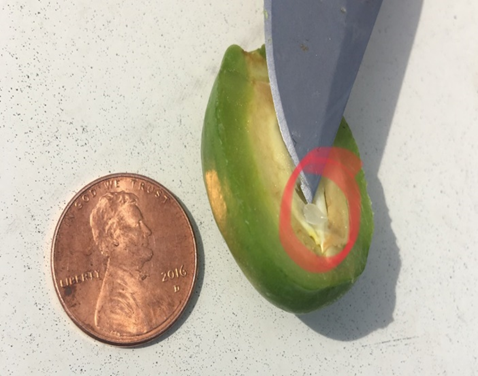Franz Niederholzer, UCCE Farm Advisor, Colusa and Sutter/Yuba Counties
Dani Lightle, former UCCE Orchards Advisor, Glenn, Butte & Tehama Counties
There is no more important activity in prune growing than checking the crop load in late April (or early May this year?). Knowing the crop load (fruit/tree) in an orchard is the most critical piece of data needed to decide if shaker thinning is needed. [Knowing the crop load can also help growers plan nutrition programs for the year.]
When needed, shaker thinning can significantly improve a grower’s bottom line this year and next year. Careful, timely thinning increases A & B size fruit production, limits small, lower value prunes in the bin at harvest and improves return bloom next year.
To find out if thinning is needed, check crop load from 2-3 trees per orchard at or just before reference date, which usually falls between April 20th and May 10th, depending on bloom dates and weather since bloom (see article in this newsletter on GDH30). Reference date occurs when 80 to 90% of the fruit have a visible endosperm (see Figure 1), which is approximately one week after the pit tip begins to harden. The endosperm, a clear gel-like glob, the beginning of the developing seed, will be found in the seed cavity on the blossom end of the prune (Figure 1) and is solid enough to be removed with a knife point. The warmer the spring, the earlier reference data arrives.

Figure 1. Extraction of the endosperm on a developing prune. When 90% of the fruit cut as in this photo shows endosperm, then the fruit can be shaker thinned if there are too many fruit on the trees.
Italic and highlighted (grey background) text shows the example numbers used in the five steps. Please insert your own numbers.
Step 1. Estimate the targeted tonnage from a given block by considering orchard history, age, etc. Let us assume a target of 3 tons/ac, and a goal of 55 dry count/lb fruit in an orchard spaced 16’ x 18’ (151 trees/acre). From there, calculate a targeted number of fruit per tree at harvest:
Step 2. Determine the actual number of fruits in a sample tree and compare that number to the target of 2,185 fruit (from step 1). Ideally, repeat this procedure on 3 representative trees to ensure accuracy. Place tarps under the tree and mechanically shake off as much fruit as possible, then hand strip any remaining fruit. Hand stripping takes extra time but is the most accurate way of knowing how much fruit is in the tree. Some growers estimate what is left after shaking.
Collect all the sound fruit and weigh them (for easy math in this example, let’s assume this weight is 100 lbs.). Take a 1-lb subsample of the fruit and count how many sound fruit are in a pound (easy math assumption: 90 fruit/lb.). Don’t count fruit that looks like it wouldn’t have stayed on the tree until harvest: these fruits are light green or otherwise look slightly “off” compared to the strong (larger, dark green) fruit. Then use those fruit/pound numbers to determine the total number of fruits per tree:
Step 3. Decide if you need to thin. Subtract the target number of fruit (at harvest) from the number of good fruits on the tree now (reference date). In this example, there is roughly 4 times the number of fruits on the tree than desired to hit the target of 55 dry count/lb. You don’t want to simply remove all those extra fruits, because you need to account for natural fruit drop and variability in fruit per tree across the orchard. Estimates of natural fruit drop range from 10% to 50%. Selecting the appropriate drop percentage should account for orchard history, as well as your own risk threshold. Many experienced growers prefer to leave approximately 50% more fruit on the tree after mechanical thinning than they want remaining on the tree at harvest:
Step 4. Calculate how many fruit to remove by subtracting the adjusted target number from the actual number of prunes on the tree:
Step 5. Shaker thin (if needed). Use harvest machinery (shaker) to remove the approximately 5,700 excess fruits. Shake a tree for one second, and following the steps above, calculate how many fruits were removed. If needed, increase the shaking time until the desired fruit numbers are removed. Typical shaking time is 2 to 4 seconds; avoid shaking for longer than 6 to 7 seconds to prevent unnecessary tree damage. Once you’ve calibrated your shaking time, go through and thin the block. If you are thinning for more than a week, check fruit per tree and green fruit per pound every few days to make sure that your shake time doesn’t need to be adjusted down as fruit grow, weigh more, and shake off faster.






Leave a Reply